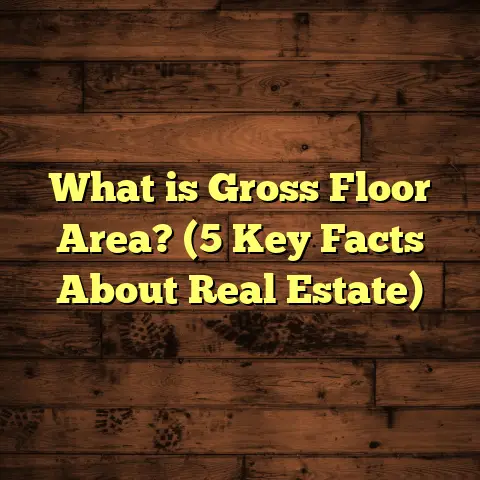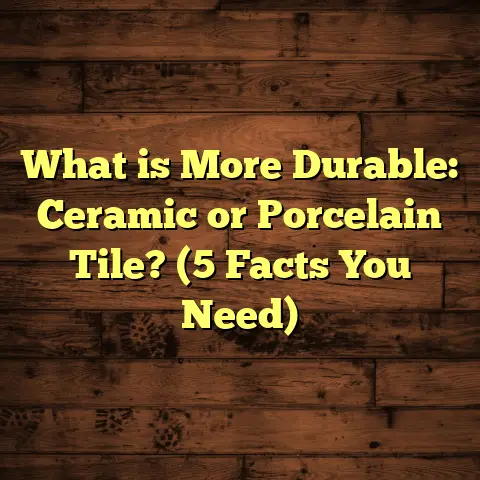What is T&G Flooring? (5 Key Benefits for Your Home)
Did you know that nearly 60% of homeowners say the flooring in their home greatly influences their buying decision? I remember when I first started working in flooring, this fact really stuck with me. Flooring isn’t just about covering a surface—it sets the tone for your entire home. It’s one of those things people might overlook until they realize how much it impacts comfort, style, and even resale value. Among the many flooring options I’ve worked with, Tongue and Groove—or T&G—flooring has been a standout favorite. It combines practicality with beauty in a way that rarely disappoints.
I want to share what T&G flooring is all about, why I think it’s worth considering, and some insights from my own experience and research. Whether you’re thinking about renovating a room or building a new home, this type of flooring might be exactly what you need.
What is T&G Flooring?
Tongue and Groove flooring is a method of joining floorboards together, creating a tight, interlocking fit. Each plank has a “tongue” — a thin, protruding ridge — on one side, and a matching “groove” — a slot — on the other. When installed, the tongue fits snugly into the groove of the adjacent board. This connection locks the boards together firmly along their edges.
You might wonder, why does this matter? Well, this system prevents gaps from forming between boards over time. Unlike simple plank floors where edges may separate due to changes in temperature or humidity, the T&G joint holds tight. The result is a smooth, flat floor surface with fewer creaks and less chance of damage.
When I installed my first T&G floor, I was impressed by how the boards practically clicked together as I laid them down. It felt almost like putting together a puzzle designed for stability. That’s the beauty of T&G: it’s both functional and intuitive.
The History of T&G
Tongue and groove joinery isn’t new. It dates back hundreds of years and has been used in woodworking and construction for walls, ceilings, and floors alike. Its endurance over centuries speaks volumes about its effectiveness.
Woodworkers originally developed this method to make floors that could expand and contract without falling apart—a common problem with wood as it reacts to moisture and temperature changes.
Materials Used in T&G Flooring
T&G boards come in various materials:
- Solid Hardwood: These are planks made entirely from one type of wood. Popular choices include oak, maple, cherry, and walnut.
- Engineered Wood: This type consists of multiple layers of wood veneer glued together, with a hardwood layer on top. It offers more stability than solid wood.
- Laminate: Some laminates have T&G edges to provide easier installation and better fit.
- Vinyl Planks: Modern luxury vinyl flooring sometimes mimics T&G to lock planks tightly.
Each material has its own benefits and price points, but the tongue-and-groove joint remains the same across them.
Why Does T&G Matter? The Science Behind the Fit
Wood expands and contracts with changes in humidity and temperature. Without a secure joint, gaps can open up or boards can warp. The tongue-and-groove system addresses this by allowing the floorboards to “float” together while holding tight.
Think of it like a zipper on your jacket—you want it snug enough to keep cold air out but flexible enough so you can move around comfortably.
This interlocking design also distributes weight evenly across the surface, which helps prevent damage from heavy furniture or foot traffic.
5 Key Benefits of T&G Flooring for Your Home
Over years of hands-on work and helping homeowners choose their floors, I’ve noticed five standout reasons why T&G flooring keeps coming up as a top pick.
1. Durability and Stability
When I first laid down T&G flooring in my own home’s living room, what struck me most was how solid it felt beneath my feet. Unlike plank floors that sometimes squeak or shift under pressure, T&G floors tend to stay put.
A study by the National Wood Flooring Association supports this observation: floors installed with tongue-and-groove joints show 30% less noise transmission compared to regular plank floors. That means fewer annoying creaks and groans when you walk around.
The durability comes from the tight joints that prevent movement between boards. This reduces wear caused by friction or dirt getting trapped in gaps.
I worked on a commercial project once where the client needed a floor that could handle heavy foot traffic daily. We chose T&G engineered hardwood because it combined strength with stability. After two years, despite constant use, the floor looked almost new—no significant warping, gaps, or damage.
2. Easy Installation
If you’re like many folks who enjoy tackling home projects yourself, you’ll appreciate how user-friendly T&G flooring can be.
When installing T&G boards, you don’t need complicated tools or techniques to get a great fit. You simply angle the tongue into the groove and then tap it down flat with a mallet or tapping block. Some installers use glue or nails underneath for extra hold, but many floating floors rely solely on the joint design.
Because everything locks together neatly, you don’t have to worry about uneven spacing or lumpy surfaces. This reduces installation errors and speeds up the process.
I remember helping a friend install laminate T&G flooring in her basement. Neither of us had done it before, but within an afternoon we had more than half the room done. The boards fit so well that we barely had to adjust anything after snapping them in place.
3. Aesthetic Appeal
There’s something satisfying about walking across a floor where every board fits perfectly side-by-side without gaps or visible seams.
T&G flooring creates a clean, polished look because the joints are hidden along the edges where the tongue fits into the groove. This seamless appearance highlights the natural grain and texture of wood beautifully.
Whether you prefer rustic wide planks or sleek narrow strips, T&G helps maintain an elegant finish.
One of my favorite projects was restoring an old farmhouse with original oak floors. We replaced damaged sections with new oak boards using the tongue-and-groove method. The new floor blended seamlessly with the old wood—no one could tell where repairs ended and original flooring began!
4. Better Moisture Resistance
Wood is sensitive to moisture. Too much water can cause swelling or buckling; too little can make boards shrink and crack.
The tight fit of T&G joints means less space for water or humidity to seep between boards. This reduces damage from spills or seasonal humidity changes.
In humid climates or rooms like kitchens and bathrooms where moisture exposure is higher, T&G floors tend to last longer than floors using simple butt joints (where edges just meet without locking).
I installed engineered T&G hardwood in my kitchen because I wanted real wood but knew spills were inevitable. Years later, I still haven’t seen any warping or gaps despite regular use.
5. Cost-Effectiveness Over Time
You might think something as solid as hardwood would break your budget—sometimes it does—but when you factor in installation speed and longevity, T&G flooring often balances cost well.
Labor usually accounts for a big chunk of flooring expenses. Because T&G floors install faster than traditional plank floors without complex fastening or leveling steps, labor costs go down.
Plus, since these floors don’t require constant repairs or replacements due to shifting boards or moisture damage, they save you money in the long run.
When I plan projects now, I always use FloorTally to get accurate cost estimates for materials and labor in my area. It helps me avoid surprises by including waste factors and local rate variations. For T&G floors especially, seeing how quickly installation goes compared to other types helps me recommend budgets confidently.
How I Use FloorTally for My Projects
You might wonder how I keep all these variables—material types, room sizes, labor costs—organized when planning flooring jobs. FloorTally is my go-to tool here.
It lets me enter precise room dimensions, pick specific materials like oak engineered T&G planks, and even customize waste percentages based on cutting patterns or mistakes expected during installation.
The tool pulls local labor rates from my region so I’m not guessing prices based on outdated info or national averages that don’t reflect my market.
I’ve found using FloorTally saves hours of juggling spreadsheets or calling multiple suppliers just for rough estimates. It gives me confidence that I’m quoting clients fairly while keeping projects profitable.
If you’re planning your own flooring job—DIY or hiring pros—I highly recommend checking out such tools to understand your budget better before buying materials.
More Detailed Insights About T&G Flooring
Let’s get into some deeper details about what makes tongue-and-groove boards tick:
How Does Expansion Work in T&G Floors?
Wood naturally expands across its width when humidity rises because fibers absorb moisture. This expansion can force boards apart if they aren’t secured properly.
With regular plank floors that just butt up against each other without locking edges, these expansions cause gaps or buckling over time.
But the tongue-and-groove joint acts like a hinge that holds boards tightly while allowing slight movement within safe limits. This flexibility protects your floor from cracking while keeping everything flat.
Types of Tongue-and-Groove Profiles
Not all tongues and grooves are created equal! There are several designs depending on manufacturer and material:
- Square Edge: Simple rectangular tongue and groove.
- Beveled Edge: Tongue or groove has a slight angle to create a more decorative joint line.
- Penny Edge: Curved edges that mimic hand-scraped wood.
- Micro-Bevel: Very slight bevel for subtle visual separation between boards.
Choosing the right profile affects installation ease as well as final look.
Case Study: A Family Room Renovation Using T&G Flooring
About three years ago, I helped a family renovate their worn-out living room floor. They wanted something durable but warm underfoot since they had young kids running around all day.
We chose engineered hardwood with a classic oak finish using tongue-and-groove planks about 5 inches wide.
Here’s what happened:
- Installation went fast: The contractor reported finishing two days ahead due to how quickly boards interlocked.
- Minimal waste: Thanks to FloorTally’s waste factor calculations, we ordered just enough material—only 3% leftover.
- No squeaking: After six months of heavy use (toys dropped daily!), no creaks appeared.
- Easy cleaning: The tight joints prevented crumbs from settling between boards.
- Family happy: The parents said it felt cozy yet elegant—the kids loved playing on smooth wooden surfaces instead of cold tile.
This project perfectly illustrated why I trust T&G flooring for family homes where durability meets style.
Troubleshooting Common Issues with T&G Floors
Even with its many advantages, tongue-and-groove flooring needs proper handling:
Problem: Boards Not Fitting Properly
If boards don’t slide smoothly into each other during installation:
- Check for debris blocking grooves.
- Ensure tongues aren’t damaged or swollen.
- Use appropriate tapping tools—not excessive force—to avoid splitting edges.
Problem: Gaps Appearing Over Time
Gaps may form if subfloor wasn’t level or if humidity fluctuates drastically without acclimation before installation.
Solution: Acclimate wood indoors for several days before laying; use moisture barriers under subfloor if needed.
Problem: Water Damage at Joints
While better than butt joints at resisting moisture, standing water can still seep through if spills aren’t cleaned promptly.
Prevent by wiping spills quickly and maintaining finish coatings regularly.
Maintenance Tips for Long-Lasting T&G Floors
Keeping your tongue-and-groove floor looking great isn’t complicated:
- Sweep or vacuum regularly to remove grit.
- Use damp mop with recommended cleaners—not harsh chemicals.
- Avoid wet mopping which can swell joints.
- Place felt pads under furniture legs to prevent scratching.
- Refinish solid hardwood every few years depending on wear.
- Monitor indoor humidity (ideally between 30-50%) using humidifiers/dehumidifiers as needed.
Following these simple steps can extend your floor’s life by decades!
Final Thoughts From My Flooring Journey
Over the years working with all sorts of flooring materials—from carpet rolls to ceramic tiles—T&G has remained a favorite for good reasons. It strikes a smart balance between craftsmanship, durability, aesthetics, and cost-efficiency that few other methods match.
If you ever get the chance to see or feel a properly installed tongue-and-groove floor up close, you’ll notice how solid it feels underfoot—and how seamless it looks across the room.
Whether you’re renovating a cozy family space or upgrading your entire house’s flooring system, I encourage you to dig into this option seriously. Ask questions about material quality and installation methods to get exactly what you want.
And remember: tools like FloorTally can help make budgeting straightforward—so no surprises at checkout time!
Have you tried tongue-and-groove flooring yet? Or maybe you’re thinking about it now? Drop me your experiences or questions—I love swapping stories with fellow homeowners who care about making their house feel truly like home!





